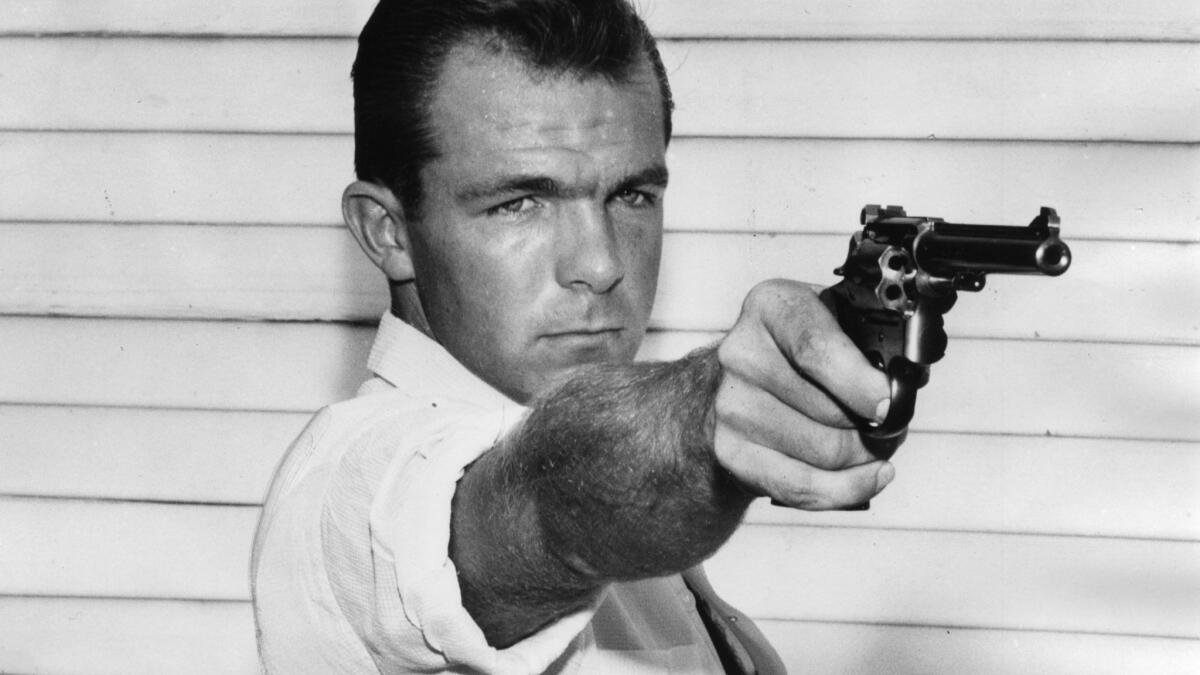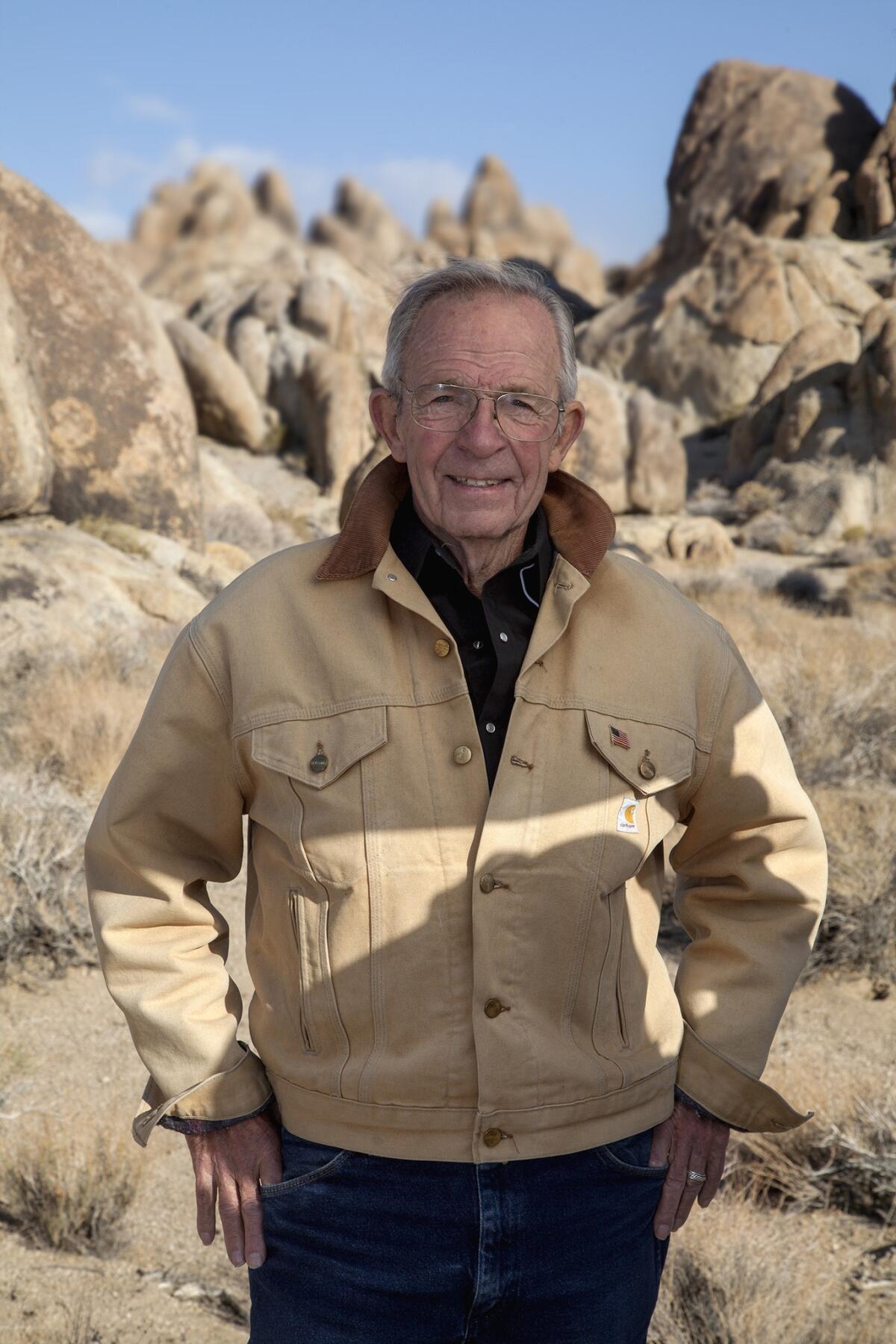Loren Janes, prolific Hollywood stuntman who jumped from cliffs, trains and speeding cars, dies at 85

- Share via
In film after film, Loren Janes leaped from speeding trains, jumped from towering cliffs and roared through city streets in gravity-defying car chases.
That’s him flying headlong into a saguaro cactus in “How the
In a career that spanned decades and with a resume that included westerns, thrillers, comedies, dramas and sci-fi, Janes was the body double for everyone including Kirk Douglas and

“There is a certain idiot element with some stunt people, but Loren was just the opposite,” said Mark Evanier, a Los Angeles-based comic book and television writer. “He took his work seriously and, remarkably, he never broke a bone.”
A lifelong Los Angeles resident, Janes died June 24 at 85 after battling Alzheimer’s disease. He outlived many of the actors he was hired to double in scenes deemed too risky for a high-paid celebrity.
When a script called for

“So I ran and dove through the window, turned a complete somersault, landed on my feet, ran, hit the corner of that wooden walkway and vaulted over two horses, cleared them totally, lit on the third horse, which was Steve’s, in the saddle and grabbed it and off and around the corner.”
McQueen was so impressed with the deftness of the stunt, Janes told National Public Radio in a 2001 interview, that he agreeably deferred stunt work to Janes thereafter. The two went on to work together for 21 years.
Janes was born in Sierra Madre on Oct. 1, 1931, and attended Pasadena City College and then Cal State San Luis Obispo before joining the Marines during the Korean War. He taught math and science at a private high school in San Fernando and made the U.S. Olympic team in 1956 and again in 1964, both times competing in the pentathlon.
He was still teaching when he heard MGM was looking for a stuntman to fill in for Williams during the cliff-jumping scene. The shot was to be filmed nearby on Catalina Island and, being an experienced swimmer and diver, he thought it seemed like easy enough work, so he took the assignment. Within six months, he’d done stunt work on seven movies.
“The principal finally called me in and said, ‘You either teach school or work in the pictures.’ I said, ‘I’ll see you later,’” he told The Times in 2002.
Though his name was largely known only within the industry, he appeared — however briefly, and however violently — in “Spartacus,” “The Magnificent Seven,” “The Ten Commandments,” “How the West Was Won,” “It’s a Mad, Mad, Mad, Mad World,” “The Dirty Dozen,” “The Graduate,” “Planet of the Apes,” “The Poseidon Adventure,” “Back to the Future,” “To Live and Die in L.A.,” “Spider-Man,” hundreds of movies and television shows in all.
He doubled for
The car chase scene in “Bullitt” — a jarring 10-minute adrenaline rush across the streets of San Francisco — became such a classic that it spawned its own subculture, websites, Google forums on where the scenes were shot, and an overlay for Google Maps that lets motorists retrace the chase route. In 2011, the Wall Street Journal even rented a Ford Mustang — albeit not the 1968 Ford Mustang GT used in the film — and took Janes on a slow-speed reenactment of the chase.
“Steve was a great driver, but he was only behind the wheel for about 10% of what you see on screen,” Janes confided during the reenactment. “He drove in scenes that required close-ups — but not in the ones that could kill him.”
Sometimes Janes went to extraordinary lengths to eliminate, of at least soften, the risk of injury.
When a director on “How the West Was Won” explained a nearly suicidal train-jumping scene to Janes, he took it all in without speaking.
“I’d like to have you get shot up here, spin and leap off and hit that cactus and go over the cliff,” the director said. “You figure it out.”
There has to be an easier way to die, he told himself. But he also went to work to make the scene happen.

Using a blowtorch, he burned off the spike-like needles on one flank of the cactus and cut the plant’s root so that the saguaro would sway when he hit it, rather than fling him back into the train, which he estimated would be going 25 to 30 mph.
“The problem was, if I missed the cactus, I’d have gone 40 feet into the rocks,” he said. “You have to do it right the first time.”
The stunt worked and the scene became another entry in a career filled with eye-catching but nearly anonymous performances.
Though he did land several small speaking parts during his career, it was generally Janes’ body, not his face, that was served up to audiences. In perhaps his easiest stunt, he was asked to play the role of Norman Chaney on the television series “L.A. Law.” In the opening scene of the show’s first episode, Chaney is found dead, never to appear again.
Later in life, Janes would lecture on the art of stunt work, and the selfless qualities body doubles must possess. He served as a board member of the Screen Actors Guild and was national chair of the guild’s stunt and safety committee. He was also a co-founder of the Stuntman’s Assn. of Motion Pictures and Television. For decades he was active with the Museum of Western Film History in Lone Pine, Calif., where he was a regular speaker. In 2001, he received a Golden Boot Award, given to actors for their contribution to westerns.
In 2016, Janes and his wife, Jan, lost their Canyon County home in the Sand fire. The blaze destroyed much of the memorabilia he’d collected during his career.
ALSO
Olivia de Havilland sues FX over unauthorized use of her identity in 'Feud: Bette and Joan'
Adam West, star of the 'Batman' TV series, dies at 88
Michael Nyqvist, Swedish star of original 'The Girl With the Dragon Tattoo,' dies at 56
Start your day right
Sign up for Essential California for the L.A. Times biggest news, features and recommendations in your inbox six days a week.
You may occasionally receive promotional content from the Los Angeles Times.





